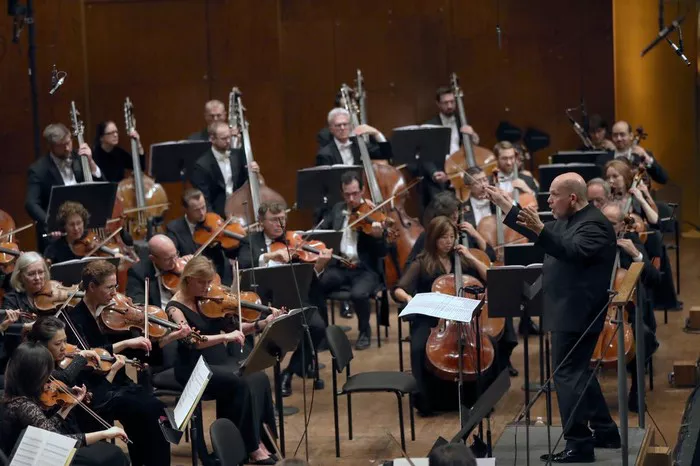In the vast realm of music, the orchestral tradition stands as a monumental pillar, echoing centuries of human creativity, innovation, and expression. From the intricate compositions of Mozart and Beethoven to the groundbreaking works of Stravinsky and Schoenberg, orchestral music has continuously evolved, reflecting the cultural shifts and artistic trends of each era. However, as we navigate the complex tapestry of contemporary music, one might wonder: What defines modern orchestral music?
Defining Modern Orchestral Music
Modern orchestral music encompasses a diverse array of styles, techniques, and approaches that have emerged in the 20th and 21st centuries. Unlike the rigid structures of classical music, modern orchestral compositions often blur the boundaries between genres, incorporating elements of jazz, electronic music, world music, and avant-garde experimentation. This fusion of influences results in a rich tapestry of sound that challenges traditional notions of orchestration and musical form.
The Evolution of Orchestral Sound
One of the defining characteristics of modern orchestral music is its exploration of timbre, texture, and sonic possibilities. Contemporary composers have pushed the boundaries of orchestration, experimenting with unconventional instruments, extended techniques, and electronic manipulation. From the ethereal atmospheres of Arvo Pärt’s minimalist compositions to the explosive energy of John Adams’ post-minimalist symphonies, modern orchestral music embraces a wide spectrum of sonic palettes.
Advancements in technology have also played a crucial role in shaping the sound of contemporary orchestral music. Electronic instruments, synthesizers, and computer software offer composers new tools for sound design and manipulation, allowing them to create immersive sonic landscapes that transcend the limitations of acoustic instrumentation. Additionally, the integration of live electronics and interactive systems enables performers to interact with their environment in real-time, blurring the lines between composition and improvisation.
Exploring New Forms and Structures
In addition to reimagining orchestral sound, modern composers have also challenged traditional forms and structures, pushing the boundaries of musical storytelling. While the symphony and concerto remain prominent formats, contemporary composers have embraced a more eclectic approach to composition, incorporating elements of chance, indeterminacy, and aleatoric techniques.
The concept of “open form” composition, pioneered by composers like Karlheinz Stockhausen and Luciano Berio, allows performers to make choices within a predetermined framework, resulting in performances that are unique and unpredictable. Similarly, the rise of multimedia and interdisciplinary collaboration has led to the emergence of new hybrid forms, such as the “orchestral theatre” pioneered by composers like HK Gruber and Heiner Goebbels, which combine music, drama, and visual elements to create immersive theatrical experiences.
Social and Cultural Commentary
Modern orchestral music is not just about sonic experimentation and formal innovation; it also serves as a platform for social and cultural commentary. Many contemporary composers use their music to explore pressing issues such as environmentalism, social justice, and human rights, shedding light on the complexities of the world we inhabit.
For example, composers like John Luther Adams draw inspiration from the natural world, creating music that reflects the beauty and fragility of the environment. His compositions, such as “Become Ocean” and “Become Desert,” immerse listeners in expansive sonic landscapes that evoke the majesty of the natural world while also highlighting the urgent need for conservation and sustainability.
Similarly, composers like Joan Tower and Jennifer Higdon use their music to address issues of gender equality and representation in the classical music world. Through their compositions and advocacy work, they challenge the male-dominated canon of orchestral music and strive to create a more inclusive and equitable musical landscape.
The Future of Modern Orchestral Music
As we look to the future, the landscape of modern orchestral music continues to evolve and expand, driven by the creative vision of composers, performers, and audiences alike. Advances in technology, changes in societal norms, and shifts in cultural paradigms will undoubtedly shape the direction of orchestral music in the years to come.
From the concert hall to the digital realm, modern orchestral music continues to captivate and inspire audiences around the world, pushing the boundaries of artistic expression and challenging our perceptions of what is possible. As we embark on this musical journey, let us embrace the diversity, innovation, and vitality of modern orchestral music, celebrating the endless possibilities of sound and imagination.
Conclusion
In conclusion, modern orchestral music defies easy categorization, encompassing a vast array of styles, techniques, and influences. From the avant-garde experimentation of the 20th century to the multimedia collaborations of the 21st century, modern orchestral music reflects the ever-changing landscape of human creativity and expression. As we continue to explore the boundless potential of orchestral music in the digital age, let us embrace the diversity, innovation, and vitality of this rich musical tradition, celebrating the enduring power of orchestral music to inspire, provoke, and move us.

